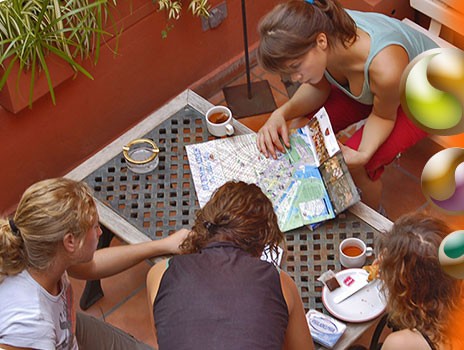Luján, in the pampas of Buenos Aires is one of the oldest cities in Argentina.

Only 70 km from Buenos Aires, Luján is an easy day trip that provides a glimpse into Argentina’s early history and culture.
The town’s crown jewel is the majestic neo-gothic basilica Our Lady of Luján that presides over the city’s main square.
The church is also home to one of the country’s most important religious artifacts: an old statue of the Virgin Mary for which the country’s saint is named.
The basilica overlooks Plaza Belgrano, a lovely colonial-style square that evokes the charm and beauty of traditional Spanish towns.
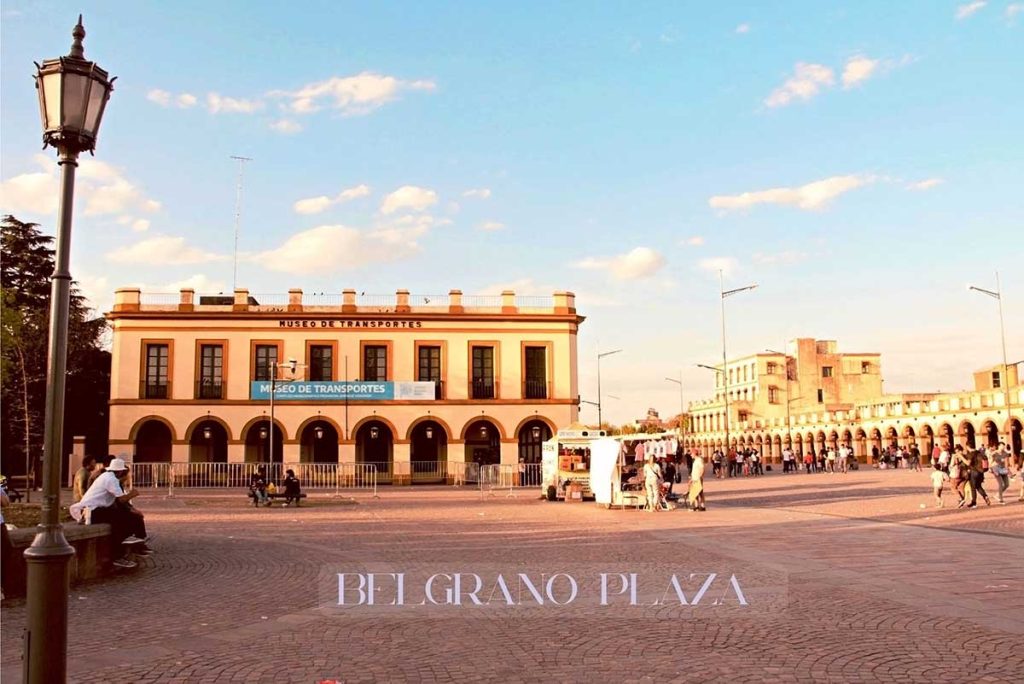
busk or sell religious trinkets.
History of Luján
Luján’s complicated and fascinating history dates back to the early colonial period when Spanish Captain Pedro de Luján, after whom the city is named, perished in the first battle attempting to conquer the area from the local Querandi people.
The Querandi were skilled fighters who utilized darts, spears, and a native weapon known as a boleadoras (a lasso like weapon with balls on the ends) and fiercely defended their land against the colonial invasion.
The Spanish eventually established a permanent colony in Luján with the help of Juan de Garay’s second attempt to establish a foothold in Buenos Aires in 1580.
This marked the beginning of the region’s development, with estancias (ranches) being parceled out in the area.
The Basilica: Our Lady of Lujan
The Basilica de Nuestra Senora de Lujan, is the town’s main attraction, drawing thousands of religious pilgrims each year.
The largest house of worship of its kind in Argentina, it’s where the Patroness is enshrined.
Various chapels previously existed on this land, but as the town grew, so did its religious importance, so the previous chapel was demolished to make room for the current huge basilica in 1887.
It took 48 years to complete.
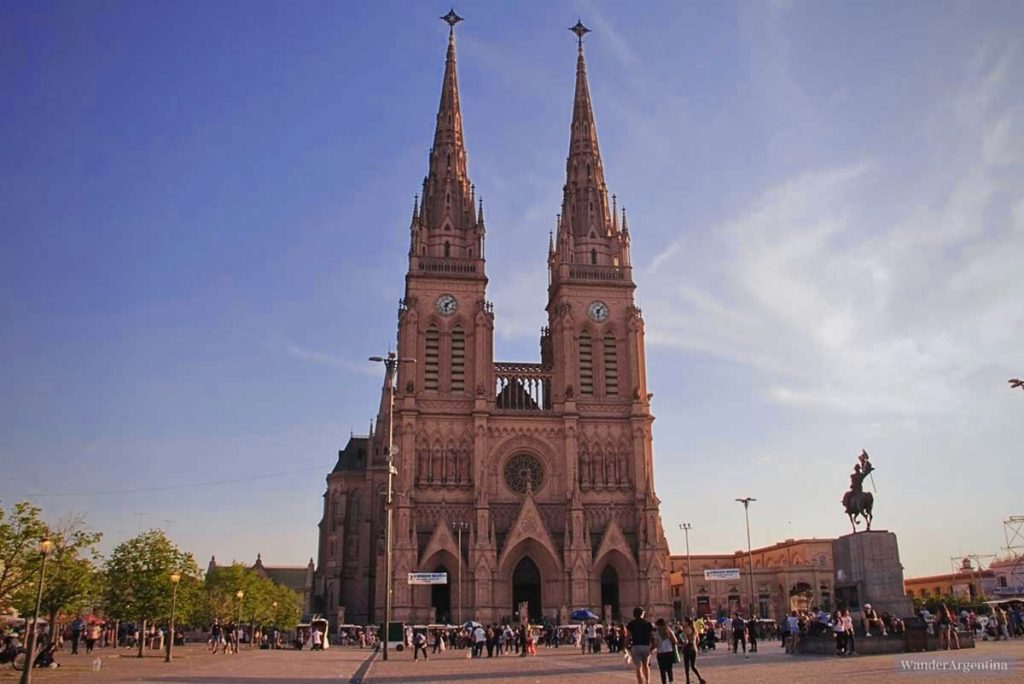
Built with ancient stone from the Tandil region (also a significant religious destination), it has two 106-meter tall spires, intricate stone carvings, creepy gargoyles and stained glass from Bordeaux.
At the center of the basilica is a baroque-style lamp with 246 bulbs that once adorned Buenos Aires’ old opera house.
Four elaborate votive lamps represent the peoples of Argentina, Uruguay, the province of Buenos Aires and Ireland, highlighting the once-strong Irish influence in the area.
Inside there are beautiful stained glass windows and the very important statue of the Virgin Mary.
Two organs highlight the excellent acoustics that can be enjoyed during regular concerts scheduled here.
Despite the size of Luján’s basilica, the cathedral of the diocese is located in the nearby city of Mercedes, another older city important in Argentina’s early history.
In 1755, the Spanish crown dubbed this pampa town, ‘Villa de Nuestra Señora de Lujan’ over a decade before they established the Vice Royalty of Rio de la Plata.
Luján’s Basilica de Nuestra Señora de Lujan, as is called in Spanish, is one of four large cathedrals in Argentina built in the gothic revival style.
The other three are located in La Plata, San Isidro (a northern suburb of Buenos Aires near Tigre), and Cordoba.
Luján’s basilica is only surpassed in size by the impressive cathedral in La Plata, the country’s largest.
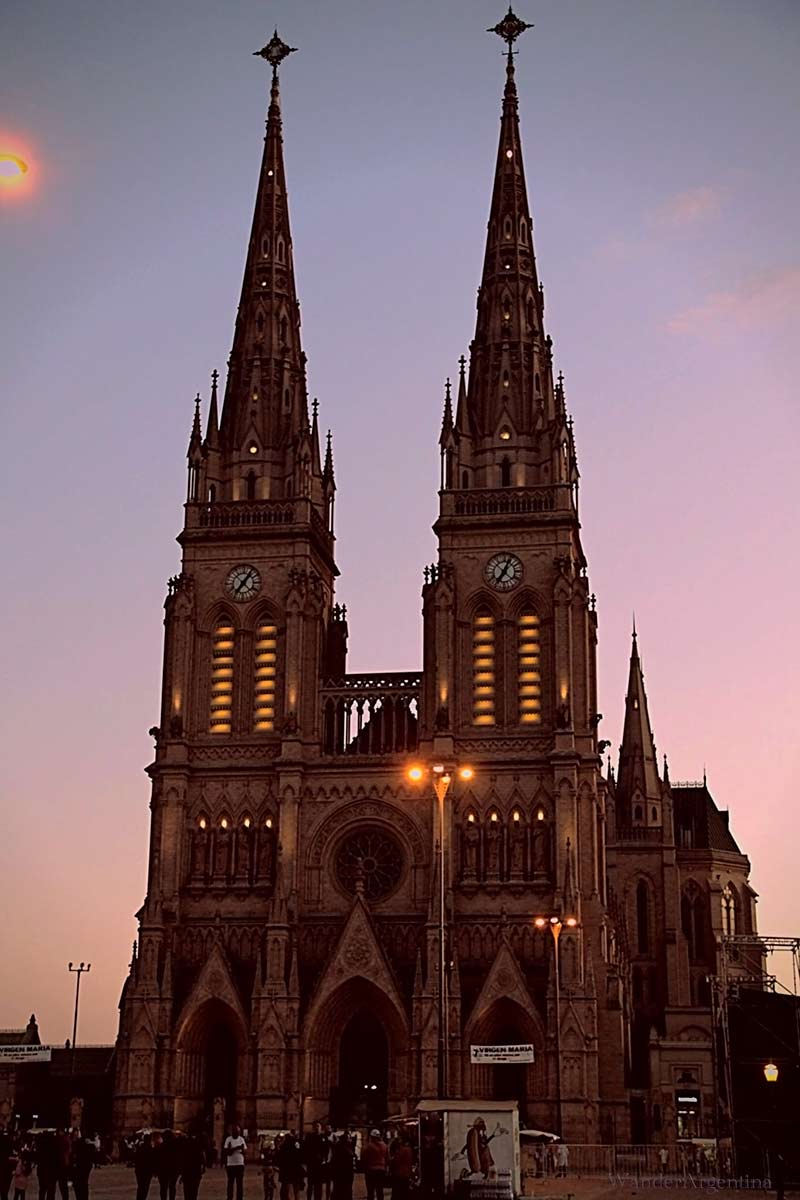
Spanish architectural influences are also evident in the prominent Cabildo, or old town hall, situated in the plaza across from the basilica, which dates back to 1792.
Throughout the centuries, it has served as a government house, school, and courthouse.
Its underground dungeons also served as a prison for British soldiers during the 1806 English Invasion into Argentina.
Today, the Luján cabildo serves as the Enrique Udaondo Provincial Museum Complex, which sprawls over three and a half blocks and contains a history and transport museum.
Argentina’s Patron Saint: The Virgin of Luján
The Virgin of our Lady Luján holds an important place in the religious tradition of Argentina.
The story behind the miracle and the Virgen Gaucha (Creole Virgin), predates the founding of Argentina by almost 200 years and is not your average saintly tale.
It was 1630, when a wealthy Portuguese man who lived in the town then known as Sumampa (now, Santiago del Estero) commissioned an image representing the Virgin Mary from Brazil.
The artist made him two different statues, so he could choose which one he preferred.
The two small painted terracotta images of the La Virgín were dispatched from Brazil by boat, landed at the port of Buenos Aires and were loaded onto a wagon to head north.
After two days of marching, the caravan reached the banks of the Luján River.
They stopped for a rest at Don Diego Rosendo’s ranch.
After the siesta the horses pulling the merchandise on a cart refused to continue.
Despite every effort, the cart was immobile until Manuel Costa de los Ríos, an enslaved man born in Brazil who was tasked with delivering the merchandise, suggested removing one of the boxes to get them out of the mud.
Out of the box fell the image of the Virgin and the caravan was finally able to move.
They declared it a miracle of the Virgin Mary, and thus the venerated Lady of Luján was born.
The statue was placed in a modest adobe chapel on the ranch on which the presumed miracle occurred.
The original image of the virgin is made of baked clay and is now encased in gold to preserve it.
Fast-forward a few centuries to 1930, and the Catholic Church officially declared Our Lady of Lujan as the patroness of Argentina.
The Official story about Manuel Costa de los Ríos, the Life-long Virgin of Lujan Devotee
The story of Manuel Costa de los Ríos, the life-long devotee of the Virgin of Luján, is a remarkable one that is only recently being included in history books.
Local priest and historian Monsignor Juan Guillermo Durán details the life of the slave who witnessed the miracle of the Virgin of Luján and became a lifelong devotee in his book.
Costa de los Ríos, was a firm believer in the supernatural power of the image of the Virgin and refused to leave her side after claiming to witness a miracle.
A wealthy widow in Luján purchased land and Manuel. She put him in charge of overseeing the statue in a modest adobe chapel and receiving visitors who came to see the Virgín of Luján.
Manuel spent the rest of his life as the sole custodian of the Virgín of Luján and aside from welcoming the faithful, was basically a hermit until his death at an advanced age in 1686.
Costa de los Ríos remains still lie underground where the former chapel was located (link in Spanish, opens in new window), only 100 meters from the current tabernacle that houses the Virgin.
In 2022, the city inaugurated a statue of Manuel caring for the Virgin along the street named ‘Negrito Manual,’ close to the basilica.
Efforts to officially beautify Costa de los Ríos in the Catholic church are underway and have been approved by the Argentine-born Pope Francis, himself a firm believer in the Virgin of Luján.
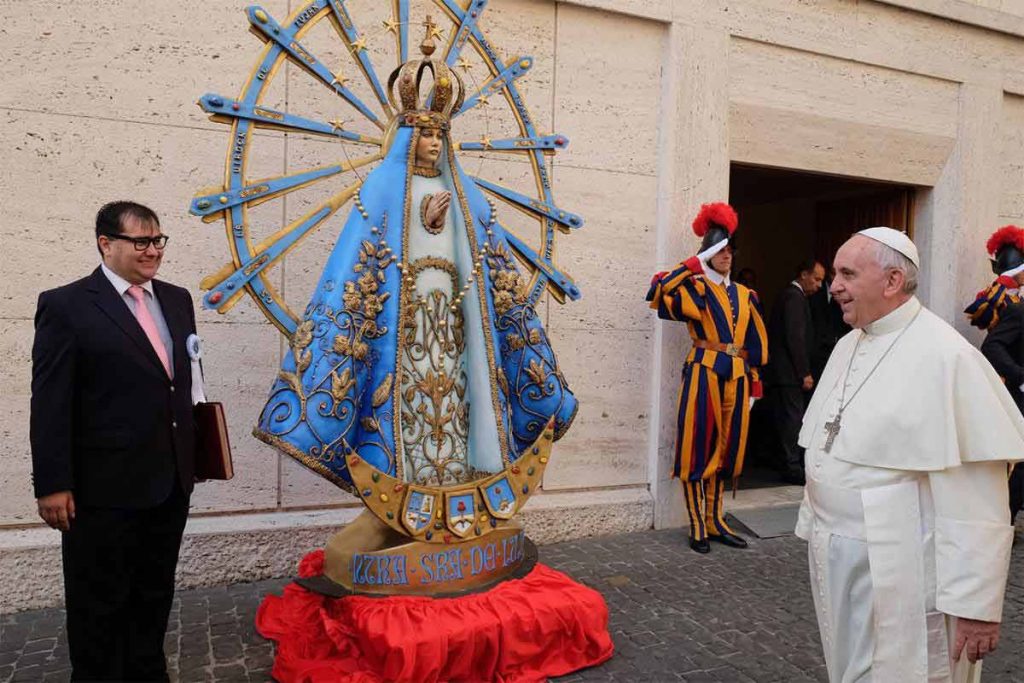
As Archbishop of Buenos Aires, Pope Francis recounted in a mass that he witnessed a miracle in the form of a spontaneous recovery of a dying girl whose father prayed to the Virgin outside the basilica all night.
The pope’s story is one of many stories of people who claim to have spontaneously received a miracle thanks to the Virgin of Luján.
Manuel Costa de los Ríos, the most loyal caretaker of Argentina’s Patroness, is the first Afro-Argentine who could possibly be canonized.
Yearly Pilgrimage to Luján
Every year, during the first weekend of October, thousands of faithful Catholics participate in the traditional pilgrimage to the Basilica of Luján.
The youth pilgrimage to Luján is one of the greatest expressions of popular religiosity in the country.
The tradition began in 1975, when some young people from a parish in Buenos Aires’ Villa Urquiza neighborhood decided to walk towards the Luján basilica.
Their humble mission to show devotion to the Virgin of Luján and to seek spiritual empowerment sparked an unexpected turnout of over 30,000 people, at a time when many young people in Argentina felt uncertain about their future.
The pilgrimage to Luján was an act of defiance at the time. The military government was on the verge of overthrowing a democratic government and the church refused to officially sanctioned the event.
The 68-kilometer-long walk from Buenos Aires to the pampas takes approximately 15 hours. Since the original pilgrimage, walking to Luján is considered a rite of passage for young people in some local Catholic youth groups.
Since Argentina’s Pope Francis became pontiff, enthusiasm for the annual event has grown.
Throughout the journey, the pilgrims are welcomed by different parishes who provide them with food and water. The pilgrimage culminates in blessings from the local priests, a celebration and mass where the pilgrims and many others congregate in unity and prayer.
In recent years, the pilgrimage continues to be an avenue for social justice and human rights advocacy. In 2022, the pilgrims carried photos of missing people to raise awareness about their cases and call for justice.
Moreover, the Afro-descendant commission from the local government highlighted the need to recognize and honor the legacy of ‘Manuelito,’ an Afro-Argentine who devoted his life to the Virgin of Luján and could become the first Afro-Argentine to be canonized.
The pilgrimage to Luján is a significant event in the lives of many Catholics in Argentina, and it attracts thousands of devotees every year.
Museums & Other Attractions
History and automobile buffs will get transported back in time in the museums of Argentina’s oldest cities.
Important early battles took place in Luján, and the history of this area is showcased in the local museum, primarily within the old Cabildo, across from the basilica.
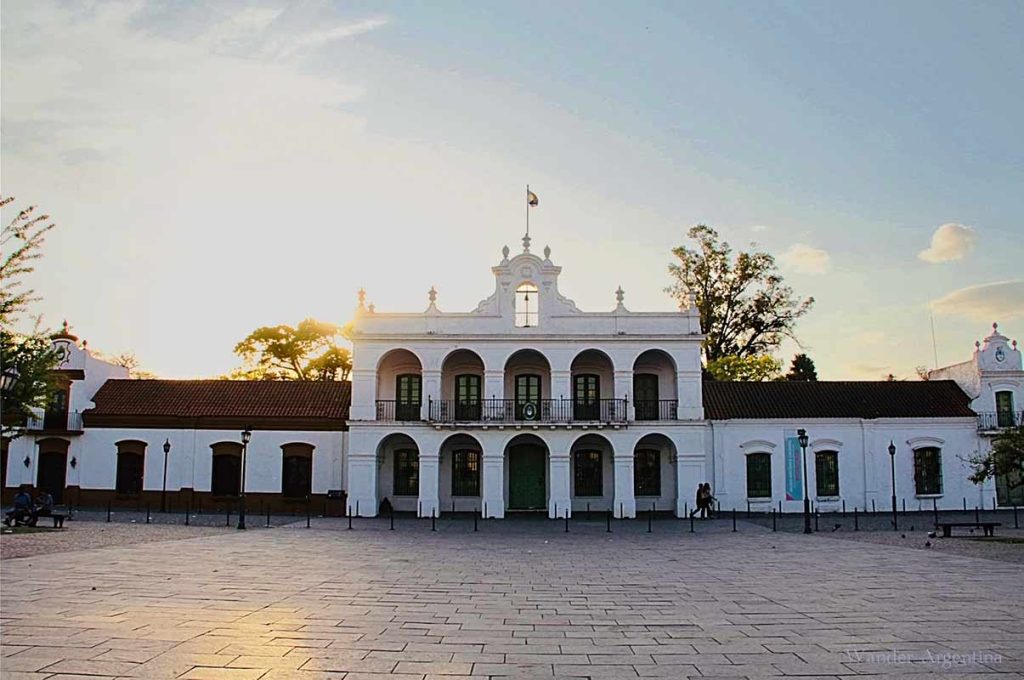
Enrique Udaondo Museum Complex
The Enrique Udaondo Museum Complex, located across from the cathedral in the old cabildo, is a sprawling collection of museums that showcases Argentina’s early history.
Named for its director of 40 years, the complex houses the Colonial History Museum, the Transport Museum, and contains an impressive automobile collection.
The museum’s collection boasts pre-Columbian artifacts, old horse-drawn carriages, retro cars, and even a tank.
The national artworks in the museum include religious pieces and depictions of gauchesco (cowboy-themed) life and tango.
Fine Arts Museum: Fernán Félix de Amador

Also steps from the church is the Museo Municipal de Bellas Artes Fernán Félix de Amador.
The museum is named after a local poet and features exhibits on the town’s history and culture.
Its collection includes over 700 works, ranging from a valuable Picasso Lithograph to pieces by contemporary Argentine artists.
Admission to the museum costs around US$2 and is sometimes free on holidays.
Those in Luján on a Sunday, will find a new outdoor sustainable market with food and beer trucks Paseo Calelián.
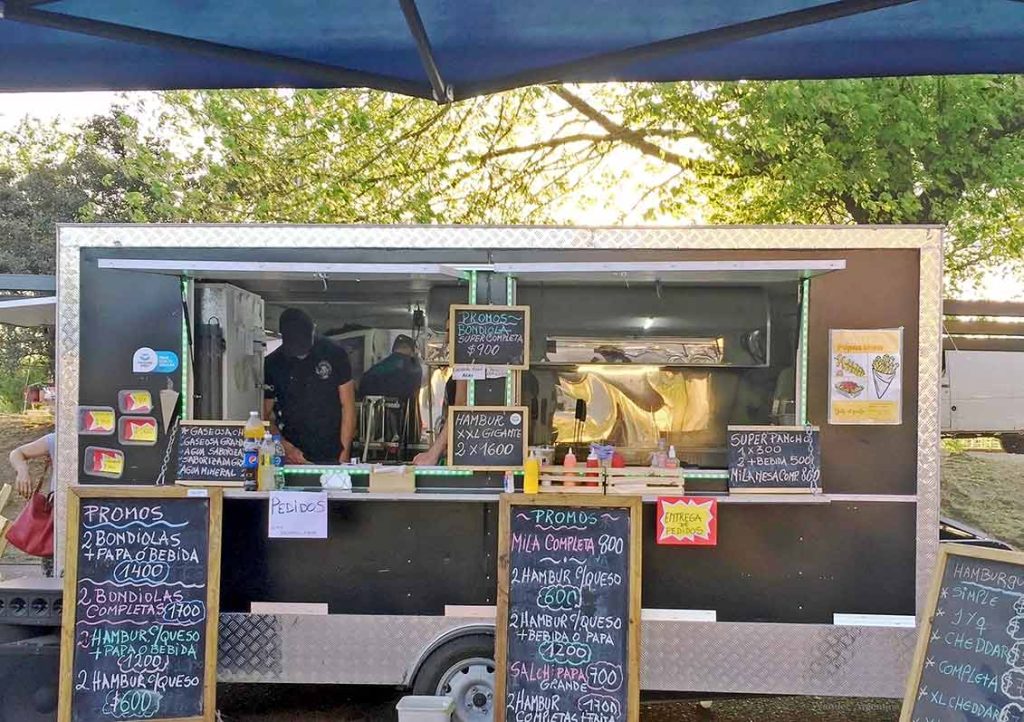
It’s the perfect spot to grab a microbrew, choripan and people watch.
The market takes place between the basilica and the Theme Park, along Padre Salvaire Avenue, so you won’t have to go far to experience the highlights of Luján.
River Walk & Theme Park
Located behind Luján’s basilica, is a market along the Luján River and a retro theme park with some old-school charm.
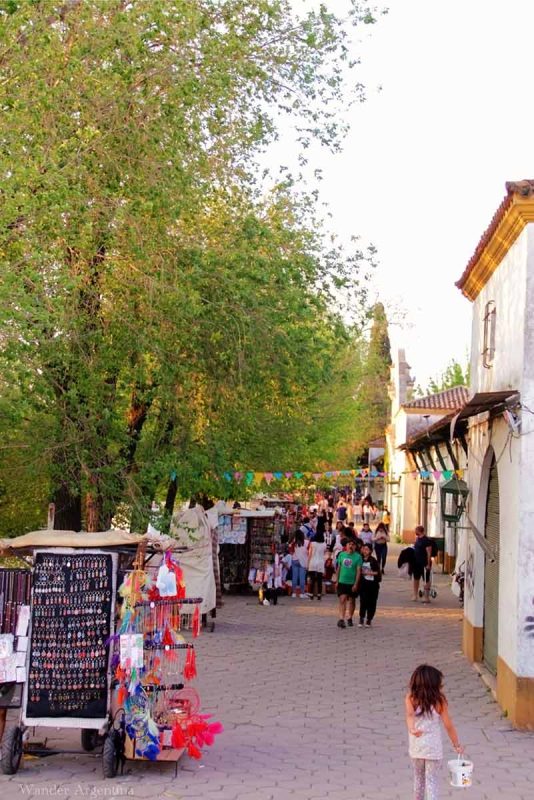
It’s free to enter to wander around the carnival-like theme park, if rides and games entice visitors, they are paid individually.
Visitors can take a ride on a chairlift, try their hand at carnival games to win prizes or hop on the bumper cars or carousel.
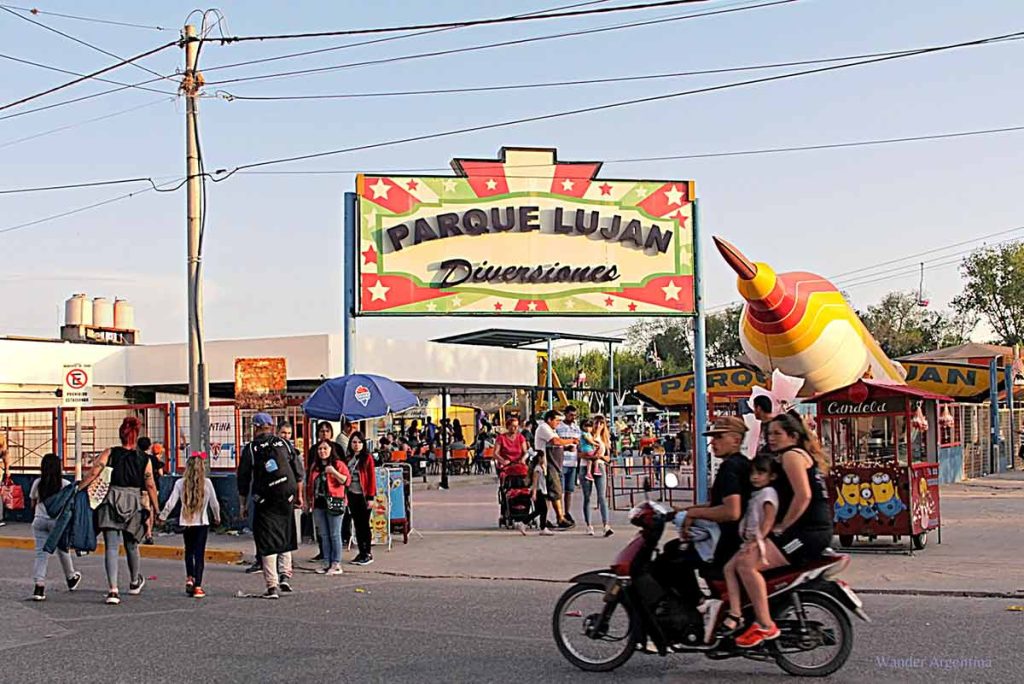
Some of the rides are vintage attractions from Italpark, a Buenos Aires theme park that operated in the 1960-90s, so take the roller coaster at your own risk.
The Closure of the ‘World’s Most Dangerous Zoo’
Did you know Argentina has its own Tiger King?
Back in the days when Luján was one of the most common day trips from Buenos Aires, the Luján Zoo was a popular attraction because the ‘extreme petting zoo’ allowed visitors to cuddle and take photos (video, opens in new window) with wild animals such as lions, tigers and bears for their social media. 😳
In recent years, animal rights activists gained attention protesting the zoo’s presumed cruel treatment toward the animals.
Among the allegations were that the animals were drugged to make them compliant enough to peacefully pose for selfies with visitors all day.

The private zoo began in 1994 and claims that many of the exotic animals were donated by people who had kept them as pets or used them for laboratory experiments and no one else would take them.
According to local news station Telefe the Luján Zoo had the largest feline population in all of South America.
Argentina’s ‘Tiger King,’ Jorge Alberto Semino claimed that the lions were heavily trained, domesticated and accustomed to human contact (video en Spanish, opens in new window), which is why they appeared complacent enough to pet and pose for photo ops.
Amazingly no one was seriously hurt at the zoo in its 36 years of operation, aside from one employee of 25-years who was lightly bitten by a tiger on the ankle (video in Spanish, opens in new window).
The zoo’s owner conceded that the conditions weren’t ideal but added the animals are too domesticated to be released into the wild.
Nevertheless, after years of complaints, the government permanently shut down the zoo in 2020 and Semino was hit with criminal charges for animal mistreatment.
Unfortunately, just like with Buenos Aires’ old zoo, the closing didn’t mean a better life for the animals and many remain on the property. Without any income, they are left neglected and it is presumed many have died.
In 2021, a beloved elephant named Sharima died at the Luján zoo, halfway through her expected lifespan.
Since the zoo’s closure, empathic neighbors come to feed the remaining animals through the fence.
The situation highlights Argentina’s struggle in granting animals human rights (as happened with Sandra the orangutang in 2019) and the harsh logistical and economic reality of shuttering zoos without a contingency plan in place.
➡ To visit a zoo that won’t put you in danger of having your limbs bitten off, check out the lone remaining zoo in the Buenos Aires metro area, Temaiken Zoo (Now ‘Temaiken BioPark’ because apparently ‘zoo’ is a taboo word now.)
Is Luján a Worthwhile Destination?
Luján doesn’t draw as much tourism as it used to but it still receives a million and a half tourists per year, mostly religious pilgrims.
Aside from the basilica (which doesn’t really seem to be a huge draw for many international tourists) a big attraction was the now-shuttered zoo, where visitors risked getting mauled by a lion for the ‘Gram.
For visitors who have seen the town previously, Lady Luján, like many other towns in the province of Buenos Aires, has let herself go a bit.
The riverfront area is unkempt and there are friendly stray dogs running amuck through the central square and even resting inside the basilica.
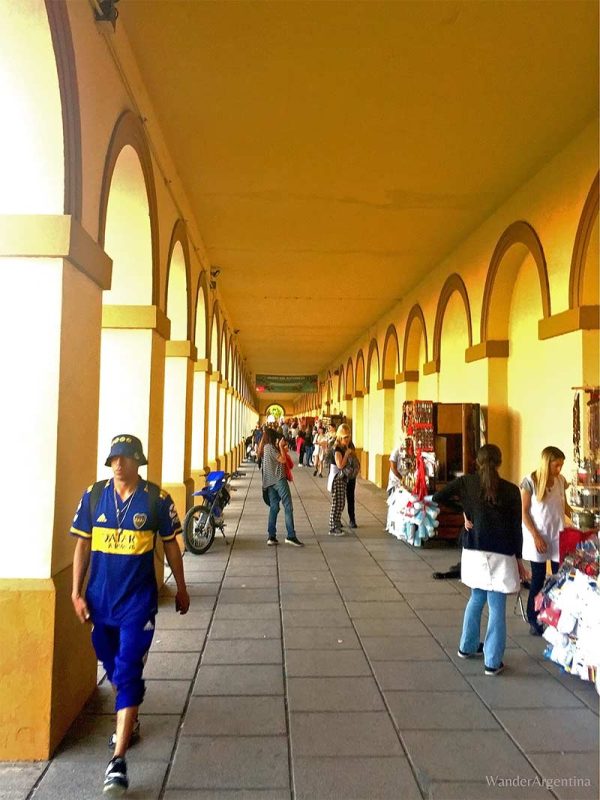
Nevertheless it’s one of the most important cities in the country’s history and serves as an agricultural and industrial hub for the pampas.
If wandering the Buenos Aires province, Luján is a worthwhile stop for urban adventurers to see the basilica, the surrounding plaza, outdoor market and museums to learn about early provincial life.
Aside from the faithful, an overnight stay in Luján would be overkill for the average tourist.
Those with their own wheels will find it worthwhile to check out some of the smaller characteristically pampa towns in the surrounding district such as Carlos Keen, Cortínez, Olivera, Open Door, Torres, and Villa Flandria for a peaceful, small town overnight stay.
Restaurants in Luján
For a heavenly meal that’s worth a pilgrimage, L’eau Vive is the holy grail of restaurants in Luján.
It’s a bit of a trek outside of the city center, but where else in Luján can you find French food served by international Carmelite nuns? Go on a nice day to enjoy the lovely outdoor seating area.
For those who prefer grilled meat, La Cholula is a parilla set in a rustic country setting. This is one of the most popular places in town for Argentine specialties like asado.
For old-world charm and mouth-watering steaks or pastas, Restaurante 1800 has the ambiance of an antique food store and serves up Argentine specialities at reasonable prices. A reservation is recommended.
Luján’s Nightlife
While Luján may be known for its religious significance, a less pious side comes out after dark.

The town is a popular stop for motorcycle riders and rockers alike. The town gave birth to the legendary rock and blues musician, Pappo who remains popular almost 20 years after his death.
There’s also a thriving folkoríco scene so a local peña (folkloric dance party) shouldn’t be too hard to find.
For a lively night out in Luján, head a few blocks east of the river toward Plaza Colón along San Martín street.
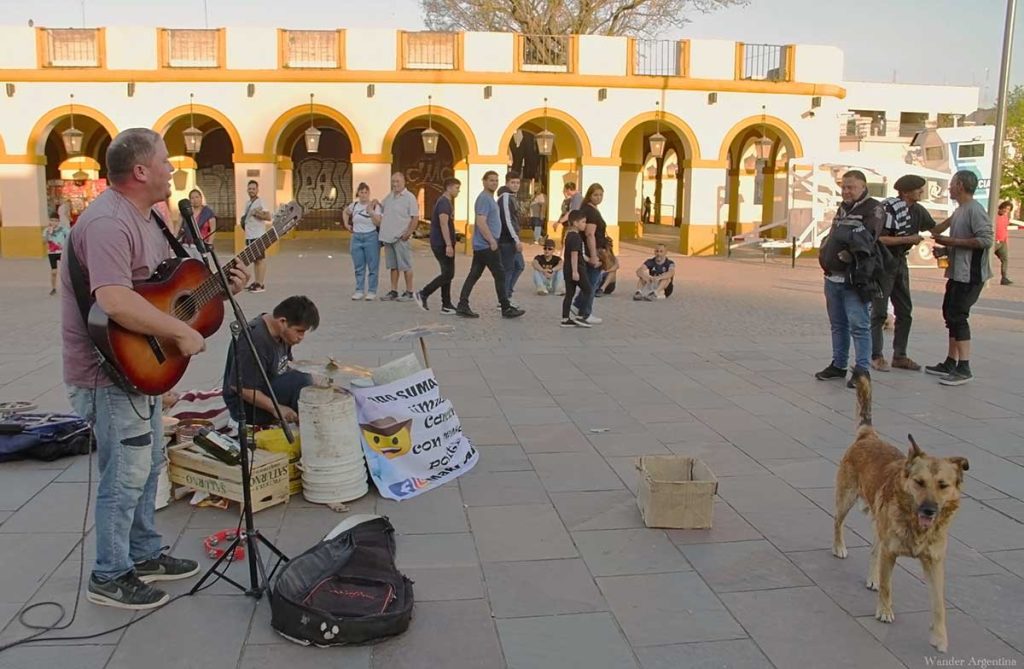
Here you’ll find a nightlife area mostly active Thursday–Sunday with plenty of pubs to choose from, including The Galway, Baum Cerveza Artesanal, and Cervecería Tropel.
For fancy cocktails and possibly dinner and a show, the Jockey Club also located on San Martín often has a DJ spinning tunes or live rock and roll.
Those who want to dance like a virgin while in Luján, will find Kalahari disco is just two blocks further down San Martín street.
Annual Events & Festivals in Luján
If visiting Luján, an ideal time is any day having to do with Virgin Mary. The town has quite a few special dates where visitors will find extra activities and photo ops.
The city’s most important dates are:
• May 8 – Feast Day of Our Lady of Luján, Patroness of Argentina. A day to celebrate the virgin with a procession and special mass with festivities.
• First weekend in October – Luján Receives Pilgrims who have walked from other parts of Argentina
Other dates with special events:
• March 17, Irish celebrate St. Patrick’s Day
• Easter — Large procession through town and mass at that cathedral
• October 17 – the town’s birthday
• December 8, Day of the Virgin (Día de la Inmaculada Concepción de la Virgen)
Transportation to Luján
Located only 68 kilometers northwest of Buenos Aires, Luján is easy to reach for a day trip from the capital by bus, car or train.
Bus
There are several bus companies that operate between Buenos Aires and Luján, including Buenos Aires’ Line 57, which offers frequent services throughout the day
The bus ride takes approximately 1 hour and 30 minutes, depending on traffic and the route taken.
By Car
The journey from Buenos Aires to Luján takes approximately 1 hour and 15 minutes by car, on National Route 8. See our driving information and rental car page for tips.
Train
To get to Luján by train take the Sarmiento Line, which connects Luján with Buenos Aires, originating at Once Station in central Buenos Aires.
The trip takes about two hours by train, but it’s cheaper than the bus.
Luján’s railway station is conveniently located in the city center.
Hotels in Luján
V&S Boutique Hostel is a place to stay that ticks all the boxes.
It’s reasonably priced, clean, and offers guests a wide range of activities.
It is also located in the thick of the action downtown — this could be either a plus or a minus, depending on what you’re after.
This post includes affiliate links. If you make a booking we receive a small commission at no extra cost to you ❤️.
A Laid-Back but Social Downtown Hostel
Most Buenos Aires hostels are gathered around the tango bars and steak houses of San Telmo, or the bars and clubs of Palermo, but the microcentro area offers a happy compromise.
The corner of Viamonte and Suipacha streets lies two blocks walking distance of the pedestrian thoroughfare of Florida and Galeria Pacificos, a shopping mall that contains the Borges Cultural Center.
It’s also two blocks away from the spectacular Teatro Colón, among the world’s most celebrated opera houses.
Transportation is no problem here with numerous bus stops and subway lines running nearby.
Getting to San Telmo from the V&S takes less than 30 minutes on foot, and is even quicker by public transport or by using one of the city’s free bikes.
Palermo is slightly further away but still easy to reach from here.
The only drawback of being based downtown is the noise and hustle of a typical working day, which confront you as soon as you step out the door.
If you can cope with that, you’re in a very convenient spot for a fun stay in Buenos Aires.
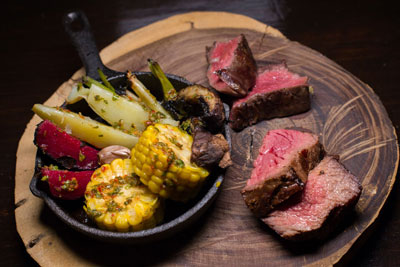
Discover Argentina’s Asado Tradition in a friendly, fireside atmosphere.
The Space: Peaceful but Social
Inside, the V&S is relaxed and comfortable.
Typical Argentine early 20th-century elegance is reflected in details such as the antique elevator, the cozy library and the French balconies and terrace overlooking a park.
The communal area is sunny and spacious, decorated with touches of rural Argentina.
It’s also dominated by a gigantic TV, perpetually alternating between movies and sports, depending on who has wrestled control of the remote.
V&S offers all the standard features you would expect from a good hostel.
The price of your room includes a buffet breakfast (until 10:30 am), introductory Spanish and tango lessons, and personal lockers (bring your own lock for extra security).
Internet access and laundry are available for a small fee.
The staff helps arrange trips to the usual attractions such as football games, theater and tango shows.
The management also finds a good balance between encouraging a peaceful environment for guests who need their rest, while providing plenty of opportunities to socialize.
Group dinners are arranged a couple of times a week they can get guests discounts at various recommended nightspots every night of the week.
On Thursday, Friday, and Saturday nights the hostel puts on live shows highlighting Argentine genres of music, such as tango and national rock, giving guests the chance to experience the local scene.
Rates vary slightly depending on season and length of stay, but the cheapest option is the 8-person room.
Four-bed rooms, with either external or internal bathrooms, are a slightly more expensive alternative.
Private rooms for solo travelers or couples with a small balcony and private bathroom are also available.
A huge plus is that all rooms have air conditioning and heating, an important feature during Buenos Aires’ chilly winters and muggy summers.
If you’re looking for a downtown hostel in Buenos Aires, head to V&S for a more relaxed environment.
If partying is on the agenda, check out the nearby Milhouse Hostel on Avenida de Mayo.
Book V&S Hostel Online
Viamonte 887 (corner of Suipacha)
Retiro/Downtown
Accommodations in Luján range from budget-friendly hostels to more luxurious hotels and guesthouses, but Airbnb hasn’t caught on here yet, but Booking has some longer-term options.
If willing to shell out U.S.$40 or so, you’ll find a decent level of comfort in Luján.
Local hosterias offer comfortable rooms, a restaurant serving Argentinean cuisine, and a cozy outdoor patio.
The highest end option is the Wyndham Garden Hotel, which has a pool, spa and all the regular five-star amenities. It also overlooks the polo grounds.
Visitors to Luján should be aware that the town can get quite crowded during peak pilgrimage seasons, particularly in October when the feast day of Our Lady of Luján is celebrated.
It’s best to book accommodations if heading there during pilgrimage season.
Alternatives to Staying in Luján
Luján gets a little gritty at night, so an alternative to staying overnight here is to stay on an estancia in one of the more quaint pueblos nearby.
Twenty minutes away is the town of Carlos Keen.
The 500-person pueblo was a wild west style hangout in the 1930s until the railroad closed down.
In Carlos Keen, Estancio Don Aniceto is a ranch that is a peaceful alternative to staying in Luján, offering both traditional suites and ‘glamping’ in luxury tents.
Another alternative to staying in Luján partido if exploring the province, is to go 52 km further west to the classic gaucho town of San Antonio de Areco.
Visitors can have a more leisurely overnight stay on a San Antonio de Areco estancia in a town better suited to tourism.
-For concerts and mass time see the webpage linked above
Tours of the Basilica are available via pre-arrangement.
The best times to visit are:
Monday— Friday: 10:00 a.m. — 4:00 p.m. & Saturdays: 1:00 p.m. – 5:00 p.m.
During these hours you can see neo-Gothic architecture up close in the courtyard of the Basilica.
• Museum Complex Enrique Udaondo, Torrezuri 917
Hours: Thursday and Friday from 11 a.m. — 5 p.m.
Saturdays, Sundays and holidays from 11 a.m. — 6 p.m.
Cost: Approximately US$ 2
